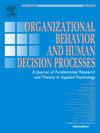The common behavior effect in norm learning: When frequent observations override the behavior of the majority
IF 3.8
2区 管理学
Q2 MANAGEMENT
Organizational Behavior and Human Decision Processes
Pub Date : 2025-10-10
DOI:10.1016/j.obhdp.2025.104441
引用次数: 0
Abstract
Prior research suggests that descriptive norms correspond to what most people do—the “behavior of the majority.” We examine norm perception in situations where the behavior of the majority differs from the most frequently observed behavior—the “common behavior.” In environments where individuals learn descriptive norms through repeated observations of a reference group, we propose that perceived norms align more closely with the common behavior than with the behavior of the majority. Consequently, individuals are more likely to follow the common behavior, even when it differs from what most people do. We argue that this ‘common behavior effect’ arises from a combination of two factors: the structure of the information environments in which the behavior of the majority and the common behavior differ, and imperfect source memory of the observed behaviors. We provide evidence for the basic phenomenon and test two moderators in four studies reported in the body of the article and two ancillary studies reported in the appendix. These findings are important for our understanding of social norms, because they challenge the assumption that norms simply reflect the behavior of the majority. They also cast light on phenomena such as pluralistic ignorance, majority illusions in online and offline environments or the spread of misinformation on social media. Finally, they have practical implications for how to shape norms in organizations.
Organizational Relevance and Contribution Statement
Organizations frequently rely on social norms to promote coordination, compliance, and shared expectations among employees, customers, or citizens. Our research shows that people often infer norms not from what most people do, but from what they observe most frequently — even when these behaviors are enacted by only a minority. This ”common behavior effect” highlights that perceptions of what is typical can be shaped by how information is encountered rather than by actual majorities. For managers and policymakers, this insight has direct implications. Efforts to influence behavior—such as encouraging ethical conduct, adoption of safety practices, or participation in diversity initiatives—may fail if interventions rely on communicating the behavior of the majority but neglect the behaviors people encounter most often. Norm-based strategies can be strengthened by structuring information environments so that desirable behaviors are both visible and repeatedly observed, even if they are not yet the majority choice. By clarifying when and why common behaviors override actual majorities in shaping norms, our findings help organizations design communication and training programs that more effectively guide employee and consumer behavior, reduce the persistence of harmful practices, and prevent misperceptions that contribute to misinformation or organizational drift.
规范学习中的共同行为效应:当频繁的观察压倒了大多数人的行为
先前的研究表明,描述性规范与大多数人的行为相对应,即“大多数人的行为”。我们在大多数人的行为不同于最经常观察到的行为——“普通行为”的情况下研究规范感知。在个体通过反复观察参照群体来学习描述性规范的环境中,我们提出,感知规范与共同行为的关系比与大多数行为的关系更密切。因此,个人更有可能遵循共同的行为,即使它与大多数人的行为不同。我们认为,这种“共同行为效应”源于两个因素的结合:信息环境的结构,其中大多数人的行为与共同行为不同,以及观察到的行为的不完善的源记忆。我们为基本现象提供证据,并在文章主体报道的四项研究和附录中报道的两项辅助研究中测试了两个调节因子。这些发现对我们理解社会规范很重要,因为它们挑战了规范仅仅反映大多数人行为的假设。它们还揭示了诸如多元无知、在线和离线环境中的多数错觉或社交媒体上错误信息的传播等现象。最后,它们对如何在组织中塑造规范具有实际意义。组织相关性和贡献声明组织经常依赖社会规范来促进员工、客户或公民之间的协调、遵从和共享期望。我们的研究表明,人们通常不是根据大多数人的行为,而是根据他们最经常观察到的行为来推断规范——即使这些行为是由少数人制定的。这种“共同行为效应”强调,对典型行为的看法可以由信息的遭遇而不是实际多数来决定。对于管理者和政策制定者来说,这种见解具有直接意义。如果干预措施依赖于沟通大多数人的行为,而忽视了人们最经常遇到的行为,那么影响行为的努力——比如鼓励道德行为、采用安全措施或参与多样性倡议——可能会失败。基于规范的策略可以通过构建信息环境来加强,这样人们就可以看到并反复观察到理想的行为,即使它们还不是大多数选择。通过澄清在规范形成过程中,常见行为何时以及为何凌驾于实际多数,我们的发现有助于组织设计沟通和培训计划,从而更有效地指导员工和消费者的行为,减少有害做法的持续存在,并防止导致错误信息或组织漂移的误解。
本文章由计算机程序翻译,如有差异,请以英文原文为准。
求助全文
约1分钟内获得全文
求助全文
来源期刊
CiteScore
8.90
自引率
4.30%
发文量
68
期刊介绍:
Organizational Behavior and Human Decision Processes publishes fundamental research in organizational behavior, organizational psychology, and human cognition, judgment, and decision-making. The journal features articles that present original empirical research, theory development, meta-analysis, and methodological advancements relevant to the substantive domains served by the journal. Topics covered by the journal include perception, cognition, judgment, attitudes, emotion, well-being, motivation, choice, and performance. We are interested in articles that investigate these topics as they pertain to individuals, dyads, groups, and other social collectives. For each topic, we place a premium on articles that make fundamental and substantial contributions to understanding psychological processes relevant to human attitudes, cognitions, and behavior in organizations. In order to be considered for publication in OBHDP a manuscript has to include the following: 1.Demonstrate an interesting behavioral/psychological phenomenon 2.Make a significant theoretical and empirical contribution to the existing literature 3.Identify and test the underlying psychological mechanism for the newly discovered behavioral/psychological phenomenon 4.Have practical implications in organizational context

 求助内容:
求助内容: 应助结果提醒方式:
应助结果提醒方式:


